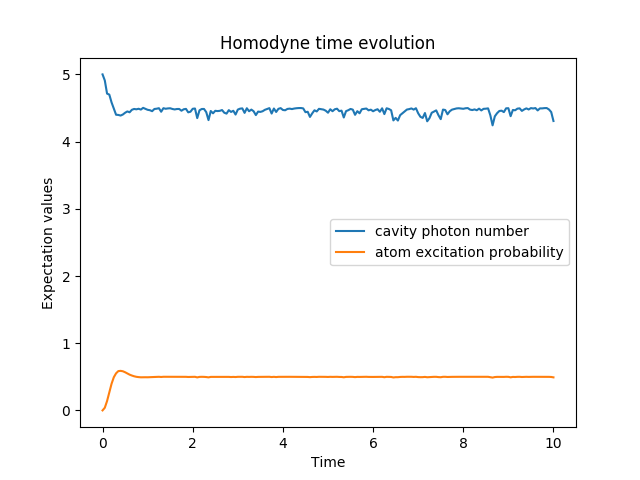Stochastic Solver¶
Homodyne detection¶
Homodyne detection is an extension of the photocurrent method where the output is mixed with a strong external source allowing to get information about the phase of the system. With this method, the resulting detection rate depends is
With \(\gamma\), the strength of the external beam and \(C\) the collapse operator. When the beam is very strong \((\gamma >> C^\dag C)\), the rate becomes a constant term plus a term proportional to the quadrature of the system.
Closed system¶
In closed systems, the resulting stochastic differential equation is
with
Here \(\delta \omega\) is a Wiener increment.
In QuTiP, this is available with the function ssesolve.
In [1]: times = np.linspace(0.0, 10.0, 201)
In [2]: psi0 = tensor(fock(2, 0), fock(10, 5))
In [3]: a = tensor(qeye(2), destroy(10))
In [4]: sm = tensor(destroy(2), qeye(10))
In [5]: H = 2 * np.pi * a.dag() * a + 2 * np.pi * sm.dag() * sm + 2 * np.pi * 0.25 * (sm * a.dag() + sm.dag() * a)
In [6]: data = ssesolve(H, psi0, times, sc_ops=[np.sqrt(0.1) * a], e_ops=[a.dag() * a, sm.dag() * sm], method="homodyne")
Total run time: 0.03s
In [7]: figure()
������������������������Out[7]: <Figure size 640x480 with 0 Axes>
In [8]: plot(times, data.expect[0], times, data.expect[1])
������������������������������������������������������������������Out[8]:
[<matplotlib.lines.Line2D at 0x2b22694b2cf8>,
<matplotlib.lines.Line2D at 0x2b22694b26a0>]
In [9]: title('Homodyne time evolution')
�����������������������������������������������������������������������������������������������������������������������������������������������������������������������Out[9]: Text(0.5,1,'Homodyne time evolution')
In [10]: xlabel('Time')
���������������������������������������������������������������������������������������������������������������������������������������������������������������������������������������������������������������������Out[10]: Text(0.5,0,'Time')
In [11]: ylabel('Expectation values')
�������������������������������������������������������������������������������������������������������������������������������������������������������������������������������������������������������������������������������������������������Out[11]: Text(0,0.5,'Expectation values')
In [12]: legend(("cavity photon number", "atom excitation probability"))
�������������������������������������������������������������������������������������������������������������������������������������������������������������������������������������������������������������������������������������������������������������������������������������������Out[12]: <matplotlib.legend.Legend at 0x2b226a6bd390>
In [13]: show()

Open system¶
In open systems, 2 types of collapse operators are considered, \(S_i\) represent the dissipation in the environment, \(C_i\) are monitored operators. The deterministic part of the evolution is the liouvillian with both types of collapses
with
The stochastic part is given by
resulting in the stochastic differential equation
The function smesolve covert these cases in QuTiP.
Heterodyne detection¶
With heterodyne detection, two measurements are made in order to obtain information about 2 orthogonal quadratures at once.